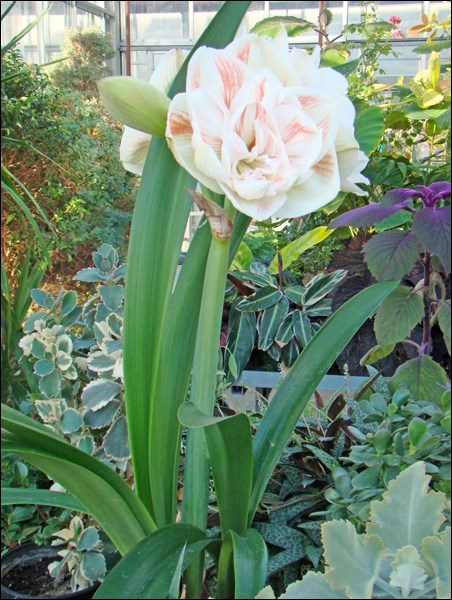A recent trip to the grocery store surprised me with a huge display of boxed Amaryllis bulbs shipped directly from Holland at the entrance to the store. These colorful boxes of bulbs promised white, red, pink or bicolor blooms by Christmas time. It was difficult to decide on one particular color so I gave in to my hoarding tendencies and purchased one of each.
The Amaryllis with which we are most familiar is a common houseplant around Christmas time. The genus (Hippeastrum), native to South America, consists of around 90 species and more than 600 hybrids and cultivars of perennial herbaceous bulbous plants.
There is a genus Amaryllis, however. Amaryllis belladonna refers to a plant originating in the Western Cape region of South Africa that has a lily-like flower and growth habit and is commonly referred to as belladonna lily, Jersey lily or naked lady. There has been a lot of discussion among botanists regarding the naming of Amaryllis and Hippeastrum. This article refers to the Hippeastrum plant that is familiar to most of us as amaryllis.
Amaryllis bulbs are usually purchased in the fall and produce beautiful large blooms around Christmas time. Bulbs can vary in size from five to 10 centimetres while the flowers can range from 10-15 centimetres in diameter. The inflorescence is made up of three outer sepals and three inner petals that are similar in appearance to each other. Flower colors include white, red, pink, striped white and red and orangey-red.
Plant the bulb in a pot that is slightly larger than the bulb itself. Place it in the container with the root (flatter side) facing down. Cover the bulb with a standard indoor potting soil media. The top half to three-quarters of the bulb must be exposed above the media. Ensure there are holes in the bottom of the container for drainage. For sprouting and growing, amaryllis bulbs prefer room temperature, 20 to 22 C.
Water your amaryllis bulb lightly at first, keeping the soil damp but not too wet. Do not pour water directly on top of the bulb as this will encourage bulb rot. Once the bulb starts to sprout, gradually increase the amount of water. The first shoots that appear from the bulb will be flat, strap-shaped leaves with parallel veins. After several pairs of leaves have developed, a tall (30 to 60 centimetre), hollow stalk will emerge from the bulb carrying anywhere from two to four blossoms. When the stalk is 15 to 20 centimetres high, water the bulb freely, but do not allow it to sit in either waterlogged or bone dry media. If a bulb is planted in late October/early November, expect the flower blossoms to emerge around mid to late December. The flower bloom can last anywhere from 2-4 weeks, depending on growing conditions. Once the flower is blooming, ensure the media remains moist.
The amaryllis is a perennial herbaceous bulb plant and if you care for your bulb correctly after blooming, that same bulb can re-grow and re-bloom indefinitely. After the flower wilts, cut the stalk (but not the leaves) at soil level. Continue to water the sprouted bulb regularly and feed a 20-20-20 fertilizer mix every two weeks. Mix the fertilizer according to label directions. In late summer, stop watering the amaryllis thereby allowing the leaves to die back slowly. Once the leaves are dead, place the bulb in a cool (10 to 15 C), dark location for about two months before starting the entire sprouting process again.
Sometimes, a healthy amaryllis bulb will produce tiny little bulblets beside the main bulb. These small bulblets can be gently separated from the mother plant and grown in their own separate containers.
If you haven’t purchased your amaryllis bulb yet, I encourage you to try one. It’s a great winter gardening project for kids as well as a chance to enjoy some bright beautiful blooms in the dead of winter.
— This column is provided courtesy of the Saskatchewan Perennial Society (SPS; saskperennial@hotmail.com ). Check our website (www.saskperennial.ca) or Facebook page (www.facebook.com/saskperennial) for a list of upcoming gardening events: Saturday, Nov. 17, 1 to 3 p.m. – Saskatoon Horticultural Society AGM at Crossmount Village Craft Barn, Lorne Ave., Saskatoon.



